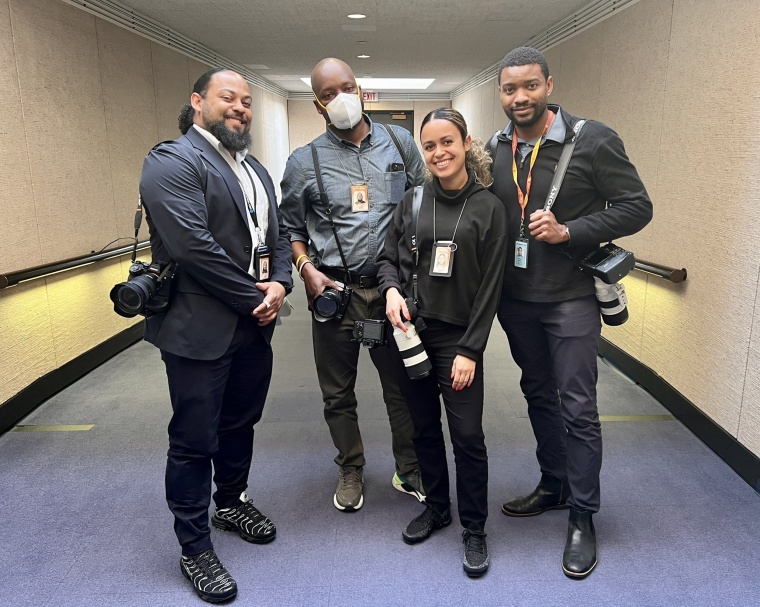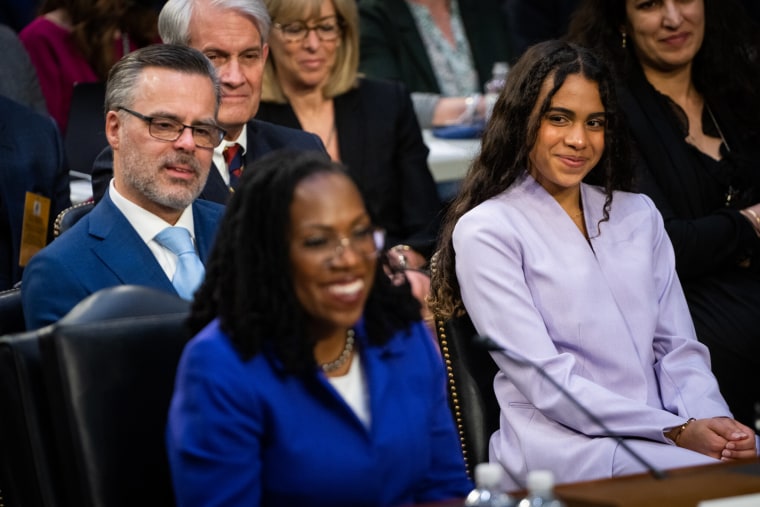Sarahbeth Maney is a Washington, D.C.-based photojournalist and a photography fellow for The New York Times. Originally from the Bay Area in California, she studied photojournalism at San Francisco State University and interned for the San Francisco Examiner, the San Francisco Chronicle and the Flint Journal in Flint, Michigan. In her role at the Times, she’s covering the U.S. Senate confirmation hearings for Judge Ketanji Brown Jackson to become the next U.S. Supreme Court Justice.
Maney captured a touching image of Jackson’s daughter Leila, 17, looking with pride and admiration at her mother as Jackson answered questions, a photo that has since gone viral. Here, Maney shares with TODAY the story behind that moving photo, and what it’s like to be a Black female photographer capturing the historic events.
When President Joseph Biden announced he would nominate the first Black woman to be a U.S. Supreme Court Justice, I raised my hand to cover the story. I wanted to provide representation and take photos that show the historic moment from my perspective as a Black woman.
When I take photos, I try to capture what I feel and not just what I see. I look for the small, intimate moments during the hearings to give readers a sense of what it feels like being in that room. As I was scanning the hearing room, my gaze fell on Judge Jackson’s daughter Leila, and I was touched by how proud she looked while looking at her mom. I felt the admiration that she held for her mother but also the pride she experienced as a young Black woman. Her look also reveals a glimmer of hope for her own future. I understood this and snapped the photo, feeling as if I caught the power of that look.
I felt the admiration that she held for her mother but also the pride she experienced as a young Black woman.
I also look for joy in the Black community and try to represent it as much as I can. Historically, we have not seen many images of Black joy or what it feels like to be a proud Black person. That look from Leila to Judge Jackson felt so joyful that I wanted others to experience it.
Being in that room, I understood a little of what Judge Jackson was going through. I know what it takes to make a place for myself in spaces that were not designed for me. These hearings were the first time in my career that I have worked with more than one other Black photographer, which is a big deal for me. I knew I was sharing a room with others who understand my experiences and emotions as we worked long days chronicling this historic event. Our perspectives added cultural nuance to how we were documenting this noteworthy first, and I felt a purpose and power in covering it.
I understood a little of what Judge Jackson was going through. I know what it takes to make a place for myself in spaces that were not designed for me.
As a photographer, I have often searched for in-between moments, those small seconds of emotion that are sometimes missed. Starting in fourth grade, I carried my camera with me everywhere. I snapped photographs of daily life in the predominately white area I grew up in as a way to process my experiences. My camera helped me translate my feelings, thoughts and identity through the images I took. Photography has always felt personal to me, and I started at young age by documenting life and being curious to learn about other people. This helps me remember snippets of time some people choose to overlook.
I had no idea when I took the photo of Leila that so many people would respond so positively to the image and her expression of pride. It wasn’t until a Times reporter told me that everyone on social media was sharing that photo that I even understood how widely it had spread. I posted it, too, so people knew that I made it, and added the caption: “Being the first often means you have to be the best — and the bravest.”

But seeing it spread so widely and shared by famous public figures, such as Martin Luther King’s daughter Bernice King, Meena Harris and other public figures, feels like the highest honor. It’s been incredible to experience such positive reactions and I hope it inspired people to be proud of who they are. Although my parents don’t do social media, they have been extremely proud and have shed many tears like I have.
I hope my images are changing the narrative. I would often watch documentaries and look for pictures of photographers at events; I’d search for a Black female photographer among them — most often to be disappointed that there were none. I want my visibility to show that Black women are fully capable of being photojournalists and achieving highs in their own careers, despite how much we have to fight for representation and respect.
I also want my picture to inspire other Black girls to turn their own lens onto the world. There are not enough Black women in photojournalism and I hope to forge a path for more to join our industry. When you’re the only one it feels difficult and I’ve experienced that — but I hope it will be different for those who come after me.
As told to Meghan Holohan
